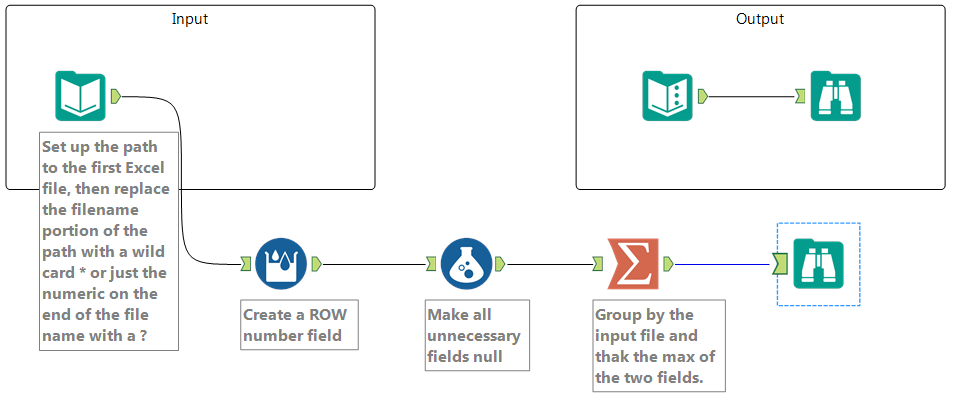Weekly Challenges
Solve the challenge, share your solution and summit the ranks of our Community!Also available in | Français | Português | Español | 日本語
IDEAS WANTED
Want to get involved? We're always looking for ideas and content for Weekly Challenges.
SUBMIT YOUR IDEA- Community
- :
- Community
- :
- Learn
- :
- Academy
- :
- Challenges & Quests
- :
- Weekly Challenges
- :
- Challenge #19: Excel Record Locator
Challenge #19: Excel Record Locator
- Subscribe to RSS Feed
- Mark Topic as New
- Mark Topic as Read
- Float this Topic for Current User
- Bookmark
- Subscribe
- Mute
- Printer Friendly Page
- Mark as New
- Bookmark
- Subscribe
- Mute
- Subscribe to RSS Feed
- Permalink
- Notify Moderator
For this week’s challenge we can look at using Alteryx to automate a repetitive task. The link to last week’s challenge (challenge #18) is HERE.
Use Case: Customer has 100's of xls files with 1 common sheet available in all workbooks. Through one process, the user would like to read across all of the xls files and return the values contained in specific cells - Row 2, Column 3 and Row 8, Column 2 for each sheet within each XLS workbook.
The result should be a table OR browse tool containing 3 columns: XLS File, Row2_ Column3, and Row8_Column2.
You will only have 2 xls files for this challenge, Book1 and Book2, but keep in mind that the use case is for 100s of Excel files with the same schema. You won’t want to use 2 input tools since that would not scale to 100’s. Also, for all data consumption, please check the box for First Row Contains Data. This is because in the headers for an Excel file are in row #1.
Good luck and keep it simple, this should be an easy challenge!
- Labels:
-
Basic
-
Core
-
Data Analysis
-
Preparation
-
Transform
- Mark as New
- Bookmark
- Subscribe
- Mute
- Subscribe to RSS Feed
- Permalink
- Notify Moderator
- Mark as New
- Bookmark
- Subscribe
- Mute
- Subscribe to RSS Feed
- Permalink
- Notify Moderator
Provided solution from @GeneR and @TaraM is more direct - attached mine below
- Added a field that only held the value for the Row2 result, and a name column
- Same for the row 8 result, and a name column
- Filtered out all blanks
- Quick transpose
- job done...
Same outcome - just a different approach
- Mark as New
- Bookmark
- Subscribe
- Mute
- Subscribe to RSS Feed
- Permalink
- Notify Moderator
Yikes!
I missed the K.I.S.S. principle here.
Chaos reigns within. Repent, reflect and restart. Order shall return.
Please Subscribe to my youTube channel.
- Mark as New
- Bookmark
- Subscribe
- Mute
- Subscribe to RSS Feed
- Permalink
- Notify Moderator
We actually used this one as a demo in a User Group meeting last year - just realized I already had the answer! Posted! :)

- Mark as New
- Bookmark
- Subscribe
- Mute
- Subscribe to RSS Feed
- Permalink
- Notify Moderator
- Mark as New
- Bookmark
- Subscribe
- Mute
- Subscribe to RSS Feed
- Permalink
- Notify Moderator
- Mark as New
- Bookmark
- Subscribe
- Mute
- Subscribe to RSS Feed
- Permalink
- Notify Moderator
- Mark as New
- Bookmark
- Subscribe
- Mute
- Subscribe to RSS Feed
- Permalink
- Notify Moderator
Ok, going through the back catalogue.
This was a nice and easy one and I assume everybody has done this in pretty much the same way:
I then used a formula to determine where it was Row ID 2 and Row ID 8, assigning the column names as the value, and assign a column to highlight these rows, and a value field to return the value of column 3 where the Row Id was 2 and column 2 where the Row ID was 8.
I then simply removed the extraneous rows and cross-tabbed the data accordingly.


- Mark as New
- Bookmark
- Subscribe
- Mute
- Subscribe to RSS Feed
- Permalink
- Notify Moderator
-
Advanced
300 -
Apps
26 -
Basic
158 -
Calgary
1 -
Core
157 -
Data Analysis
185 -
Data Cleansing
5 -
Data Investigation
7 -
Data Parsing
14 -
Data Preparation
237 -
Developer
35 -
Difficult
86 -
Expert
16 -
Foundation
13 -
Interface
39 -
Intermediate
267 -
Join
211 -
Macros
62 -
Parse
141 -
Predictive
20 -
Predictive Analysis
14 -
Preparation
272 -
Reporting
55 -
Reporting and Visualization
16 -
Spatial
60 -
Spatial Analysis
52 -
Time Series
1 -
Transform
227
- « Previous
- Next »



